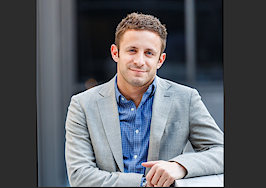All week, Inman is taking a Deep Dive into Coldwell Banker. We’re talking to key executives, unpacking the company’s strategic moves and reporting on the Gen Blue Experience event — taking place virtually and in New York this week. Stay tuned in the coming days for more on Coldwell Banker, and for future Inman Deep Dives into top brokerages.
It has been nearly two years now since M. Ryan Gorman took over the top spot at a consolidated Coldwell Banker. And it has been a wild two years: The brand has spent that time completely remaking its public image, while also navigating a global pandemic.

Ryan Gorman
Those events also happened on top of longer term trends, such as greater and greater competition in the real estate industry, as well as ongoing disruption from technology.
To get a sense of how Coldwell Banker is faring in these unusual times, Inman recently spoke with Gorman. The conversation took place in the lead up to Coldwell Banker’s Gen Blue Experience — which is happening virtually and New York this week — and the takeaway is that Gorman believes his company has emerged from the last year stronger than ever.
What follows is a version of Inman’s chat with Gorman that has been edited for length and clarity.
Give me your overview of 2021. How has it compared to your expectations?
I’d say 2021 is exceeding already high expectations. The market’s been stronger than I originally anticipated, and we’re growing our share within Coldwell Banker even more quickly than we have in the recent past. So overall I’d say 2021 has been a terrific year for Coldwell Banker.
Inman: You say you’re growing your share. But a lot of the real estate industry is doing well this year too. Why do you think Coldwell Banker, in particular, is doing better than expected?
Gorman: I think there are probably a lot of reasons. But one of the common trends right now in 2021, in an inventory constrained environment, is that the best agents tend to do even better.
So, those with the deepest relationships, the strongest history, and the strongest brand and broker behind them tend to earn a greater than perhaps their fair share of listings. And we have always been a pretty listing-centric organization. We’ve got, I think, a disproportionate share of the best agents in the business. And they’ve gotten a higher share of the business than they have in the past.
You also mentioned the inventory situation. Looking forward, are we ever going to get back to something resembling what we used to call normal? Or is there just going to be constrained inventory for the foreseeable future?
We’re certainly in a strong seller’s market today. And I see all the fundamentals remaining strong for a seller’s marketing to continue for quite some time. The demand is fundamental. It’s demand for owner occupancy. Not flip housing, not investment housing.
On the demand side, I think the existing strength is going to continue. We’ll maybe move from kind of insane demand to really very strong demand.
On the supply side, there are really no indications that new construction supply, which is currently coming on relatively slowly, is going to accelerate massively any time soon. We have shortages of labor and land, and we have builders who are only willing to invest so much ahead of the curve.
So I don’t see supply growing to meet strong demand anytime soon. And all of that stands on a foundation of, I think, affordable rates. Which means the current seller’s market probably has some legs to it.
You also mentioned that people are looking for homes to occupy themselves. That reminded me of a debate happening on social media about institutional organizations buying up a lot of houses and how that impacts the market. Does that contribute to affordability issues or to a supply shortage?
Far and away demand from consumers is the bigger factor in the market today. By a very wide margin. In some communities institutional buyers do compose a more impactful percentage of buyers, and there is what some might call a negative impact on affordability just by simply there being more demand.
But there’s a positive impact on quality of inventory. So what happened to the multifamily sector decades ago was that historically it was very much a mom-and-pop sector. Then it became institutionalized, and you began to have really quality large multifamily complexes that were built.
That started originally with institutions buying existing multifamily properties and then growing a way to develop new ones. You’re seeing the same trend on the single-family side now.
Where institutions are acquiring homes and fixing them up and renting them out. And the quality of single-family rentals is night and day compared to what it was 20 years ago. So, families that are looking to rent, and perhaps can only rent, have more quality inventory to choose from.
But overall the institutional buyers nationally still comprise a very small, even single-digit percentage in most cases. In some areas it gets up into the low double digits. But the bigger impact is from that owner-occupancy demand.
Talk to me about the rebrand. How is it going? What’s your evaluation of the project’s success?
Incredibly successful. In sort of fun and surprising ways. We’ve converted probably 90 percent of our operations today. And I think it seems like we’ve increased logo usage by more like 900 percent. It’s become such a galvanizing force. The logo is everywhere, well beyond my expectations. It’s on hats and shirts and mugs and battery chargers and pens and ascots even. People can’t get enough of the new logo.
I’m told that wearability of the new logo is off the charts. And that means we’re seeing it in social media impressions, which are hundreds of percentage points. We do some deep tracking of a handful of brokers to almost anthropologically understand how they went about the rebrand and those numbers are almost unbelievable.
There’s this interesting trend where the new North Star logo and the updated Global Luxury program appealed disproportionately to higher-end agents and presumably clients as well. We’ve got one broker who increased their luxury agent production by over 100 percent and another who increased it by over 300 percent.
So it’s really exceeded expectations.
Do you think it has moved the needle in terms of consumer perception of the brand, and if so in what ways?
Yeah. When you said that I thought of here actually, I’m in north Jersey. And one of our top agents here told me that before she was with us, prior to her choice to upgrade to Coldwell Banker, she had a client event. And at that event she told her clients that she was thinking about other brokerages and asked if they had any recommendations.
And it was her clients actually who said, “Oh yeah, you have to go with Coldwell Banker. Have you noticed the signs downtown?”
We had an office there previously, but when we did the rebrand, it gave everyone an opportunity, I guess, for us to reintroduce ourselves.
For this particular agent, I would have hoped she would have thought about us previously, but it was her clients’ feedback to her that made her reach out and say, “OK, fine. I think now is the time, let me learn more.”
I thought that was fantastic.
What do you see as the biggest challenges and opportunities for Coldwell Banker in the near future?
Right now kids are back in school. Before you know it, the holidays are going to be here. So one of the things on my mind is that buyers and sellers have just more going on right now than they did recently. Especially now that people are back out and about and traveling again. Their needs are the same, but they have less time.
So the challenge for our agents will be keeping clients informed and engaged to ensure they don’t miss an opportunity in the market, especially with things moving so quickly.
A lot the coaching and commentary we’ve given to our agents is that the closings that happen in 2022 are generated by the conversations and the information shared and the relationships developed in 2021.
We’re asking our agents to finish the year strong in the fourth quarter of this year in a way that sets them up for not just closing business in 2022, but also that will help them have up-to-the minute market intelligence to share throughout next year.
Because I think it’s going to be even harder to penetrate that sort of mental shelf space of their sphere when people have just got more going on, and life is getting closer to normal.
You mentioned you’re encouraging your agents to finish out this year strong. Are you seeing normal seasonality right now? Fall is usually a slower time after all.
We’re seeing seasonality. But I think normal might not quite apply. Definitely there was some buyer frustration and vacation happening in late summer and early September that meant that many transactions were closing with a handful of offers rather than a deluge of offers.
That trend is continuing, and it is seasonally appropriate. But in places like Florida, for instance, where you’ve got inbound demand, driven in part by population growth not just internal migration, their season appears to be almost non-existent in that it never went away. A lot of Florida’s peak season comes in the fall and winter, but even that increase in demand appears to be arriving earlier.
I was speaking with one of our newest affiliates in Florida today, and she was commenting that the train of trucks with cars on the back with northern tags is starting earlier than she can ever remember in her lifetime. And that’s a sign of the lack of seasonality in Florida.
Any final parting thoughts or observations?
I’d say watch this space. What we’ve seen recently with Coldwell Banker, as I said, exceeded expectations throughout 2021. That’s going to continue through the balance of the year.
We’ve got some fun announcements coming up here shortly, and I think some fantastic opportunities for entrepreneurs who are soon to be upgrading to Coldwell Banker. So there’s more in store for the balance of the year, and that’ll set us up for a great 2022.













